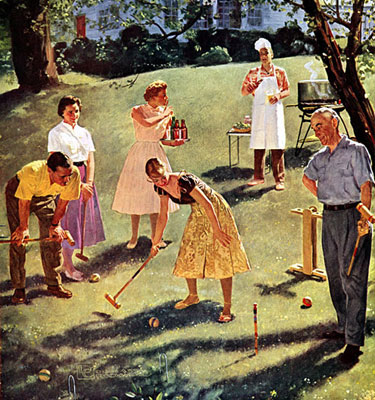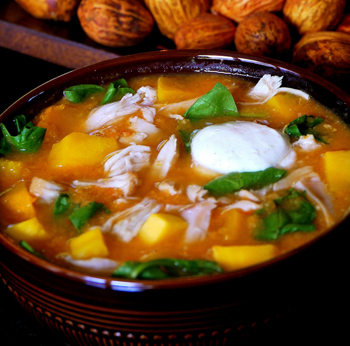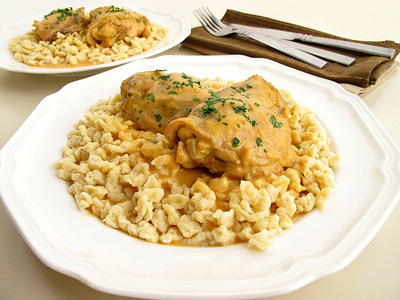 It's well known that paprika is the famous spice of Hungary. What I think most people don't realize is that the red powder is made from ripened peppers also called paprika. The word paprika means pepper in Hungarian, and I don't mean peppercorns, but rather the fruit or vegetable, depending on how you look at it. Hungarian sweet peppers are typically pale yellow to pale green in color when they are fresh. They can be eaten raw or cooked into many recipes. But when they ripen to bright red, they are dried and ground into the fine red powder known as paprika or what I like to call Hungarian gold.
It's well known that paprika is the famous spice of Hungary. What I think most people don't realize is that the red powder is made from ripened peppers also called paprika. The word paprika means pepper in Hungarian, and I don't mean peppercorns, but rather the fruit or vegetable, depending on how you look at it. Hungarian sweet peppers are typically pale yellow to pale green in color when they are fresh. They can be eaten raw or cooked into many recipes. But when they ripen to bright red, they are dried and ground into the fine red powder known as paprika or what I like to call Hungarian gold.
Hungarian paprika (pronounced puh-pri-ka) is available in sweet, hot, and everything in between, with eight varieties altogether. Sweet paprika has a deeper red color whereas hot paprika is more rusty in color. The signature dish most famous for using paprika is chicken paprikash, a stew of chicken with an onion sauce richly colored and flavored with paprika. I grew up on paprikás csirke, as it is known in Hungarian. It is my comfort food, and that's exactly what it is for so many Hungarians and Hungarian-Americans. I consider it my favorite home-cooked dish. And, of course, no recipe rivals my mother's.

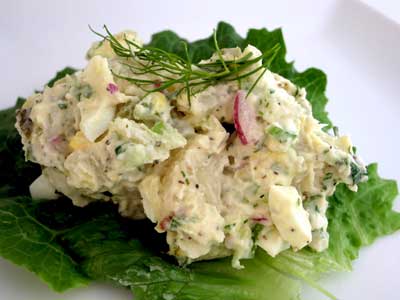 Summer barbecues just aren’t complete without this classic side dish. Everyone has a favorite version, and when I’m looking for an authentic home cooked version, this is my recipe of choice.
Summer barbecues just aren’t complete without this classic side dish. Everyone has a favorite version, and when I’m looking for an authentic home cooked version, this is my recipe of choice.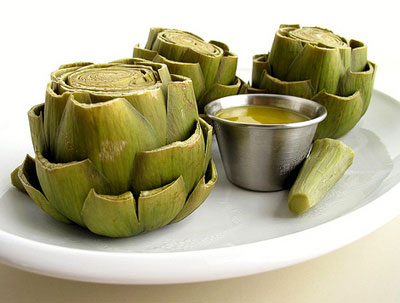 Most people look at an artichoke and think: "What do I do with this?"
But artichokes only look intimidating, they're actually easy to prepare
once you know how. Originally from the Mediterranean, artichokes have a
history that dates back to Roman times. There are countless cultivated
varieties, especially in Italy, where artichokes are enjoyed in many
different preparations including raw salads, stuffed and baked, steamed,
grilled, etc. In the States we have just two varieties: the large globe
and small baby. The simplest way to prepare artichokes is steaming. Not
only is it easy to do, the method also retains the subtle flavors that
make artichokes so revered.
Most people look at an artichoke and think: "What do I do with this?"
But artichokes only look intimidating, they're actually easy to prepare
once you know how. Originally from the Mediterranean, artichokes have a
history that dates back to Roman times. There are countless cultivated
varieties, especially in Italy, where artichokes are enjoyed in many
different preparations including raw salads, stuffed and baked, steamed,
grilled, etc. In the States we have just two varieties: the large globe
and small baby. The simplest way to prepare artichokes is steaming. Not
only is it easy to do, the method also retains the subtle flavors that
make artichokes so revered.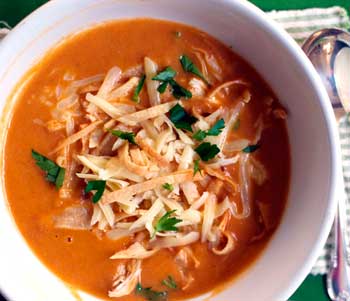 I make soup every Sunday. Along with my pre-made grains, a legume, some roasted chicken(or sauteed sausages), cleaned and prepped veggies, soup is always simmering on Sunday mornings. I meal plan. Shopping lists are written on Fridays, shopping is done on Saturday, thus the organization begins. Simply, it makes weeknight meals easier, quicker, and nutritious.
I make soup every Sunday. Along with my pre-made grains, a legume, some roasted chicken(or sauteed sausages), cleaned and prepped veggies, soup is always simmering on Sunday mornings. I meal plan. Shopping lists are written on Fridays, shopping is done on Saturday, thus the organization begins. Simply, it makes weeknight meals easier, quicker, and nutritious.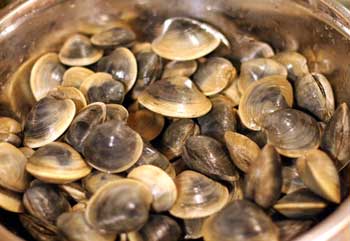 What a perfect time to declare it to be New England clam chowder week because the temperature here in Maine has been zero degrees at night and the wind has been a howling! Recipes for chowder are pretty personal around here. Some old salts would never use rendered bacon fat to sauté their onions in, they'd stop listening to you, roll their eyes and turn up their noses. Salt pork is how the old timers started chowder, period. Quahogs, not likely, either.
What a perfect time to declare it to be New England clam chowder week because the temperature here in Maine has been zero degrees at night and the wind has been a howling! Recipes for chowder are pretty personal around here. Some old salts would never use rendered bacon fat to sauté their onions in, they'd stop listening to you, roll their eyes and turn up their noses. Salt pork is how the old timers started chowder, period. Quahogs, not likely, either.